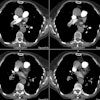Pulmonary embolism: diagnosis with spiral CT and ventilation-perfusion scanning--correlation with pulmonary angiographic results or clinical outcome.
Garg K, Welsh CH, Feyerabend AJ, Subber SW, Russ PD, Johnston RJ, Durham
JD, Lynch DA
PURPOSE: To compare the accuracy of spiral computed tomography (CT) with that of ventilation-perfusion (V-P) scintigraphy in the diagnosis of pulmonary embolism (PE). MATERIALS AND METHODS: Fifty-four patients in whom indeterminate V-P scans or discordant clinical and scintigraphic results were obtained underwent both V-P scanning and contrast material-enhanced spiral CT. The reference standard was pulmonary angiographic results in 26 patients (group I) or clinical outcome in 28 (group II). RESULTS: Six (25%) of 24 group I patients had proved PE. The prospective sensitivity and specificity for segmental or subsegmental PE were 67% and 100%, respectively, and the positive and negative predictive values were 100% and 90%, respectively. In two group II patients, V-P scans had high probability for acute embolism, but spiral CT scans showed only chronic PE; in one patients, the V-P scan had low probability and the CT scan was positive for acute PE. An alternative CT diagnosis was established in four (31%) of 13 patients in whom a normal or low-probability V-P scan was obtained. Clinical outcome was consistent with spiral CT results in all cases. CONCLUSION: Spiral CT has greater accuracy and specificity than V-P scanning in patients with an unresolved diagnosis and may be useful as the primary screening technique for PE.







